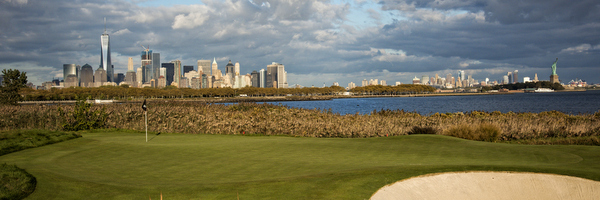About the Area

The first time you set foot on Liberty National Golf Club, the gravity of your surroundings cannot be ignored. To the east, the waters that ferried immigrants to these shores sparkle in the sun, the image of the Statue of Liberty signaling the promise of a new beginning.
To the west, the bucolic, rolling hills of the Garden State unfurl over what was part of the original 13 colonies.
And beneath your feet, an oasis of golf that enhances the land upon which it sits, reflects the mission of its founders, and respects its role in a historic region.
“I believe Liberty was waiting to happen and wanting to happen,” says the club’s co-founder Paul Fireman. “It’s a very important and precious site. The geography of this part of the country is so significant.”
It is Liberty’s homage to the past that makes it so apt to continue to thrive in the future.
Spending a day at Liberty is like a walking through an American history book. Beyond the ever-present Statue of Liberty sits New York City, the financial epicenter and heartbeat of American life. Farther south, the Verrazano Bridge stretches to connect Brooklyn and Staten Island, its reach so great that it spent part of the 20th century as the longest suspension bridge in the world.
Even the site of the golf course has a unique and layered history, including a time as an oil refinery and warehouse for industrial goods.
During the First World War, the location housed ammunition. During the Second World War, part of land was used as a prisoner of war camp.
Even as the property went through various incarnations, its destiny would be set in 1992, when that year’s United States Open champion at Pebble Beach – the World Golf Hall of Famer Tom Kite - laid eyes upon the land for the first time.
When given an aerial shot of where the potential golf course would sit – across from the Statue of Liberty, Ellis Island and Lower Manhattan – Kite’s reaction was immediate.
“Darn right I’m interested,” he said.
Kite soon enlisted his friend and co-designer, Bob Cupp, and the onset of a veritable dream team began to take shape.
When Fireman and his son, Dan, provided the backing for the building of the club, a vision for the club began to take shape. Liberty would be built at the virtual crossroads of American history and it was a fact that was lost upon no one.
Dan would live in Lower Manhattan for nearly seven years to watch Liberty come to life from New York City.
“We wanted to do this with the highest of quality,” Dan says. “This wasn’t going to be a business play. We wanted to give a gift to the world of golf.”
When the site was excavated and the earth was moved and the lush soil began to take shape, the possibilities of the club were impossible to overlook.
Eighteen unique golf holes, stretching over 7,400 yards, were grown. Belgian cart-path stones were laid down. Helipad and ferry service were included. A sparkling clubhouse rose above the 18th green, shimmering in the style of Manhattan across the water.
Less than a year after its opening on July 4, 2006, Liberty’s magnetic pull could already be felt throughout golf’s landscape as well as a New Jersey region in the midst of a rebirth.
“We are a small part of a restoration project – we happened to use golf as a medium,” Kite says. “If you go into New Jersey, Jersey City, and Hoboken – really all across the Hudson from New York City - and see what’s going on, you’d be blown away.”
Says Cupp, “It goes a lot deeper than ‘We just did a golf course.’”
In twice hosting PGA Tour events – and with more tournaments on the horizon - Liberty has not only brought prestige to New Jersey but also revenue and a sense of community.
Liberty has helped New Jersey stand shoulder to shoulder with its neighboring states as a hub of business and culture while also providing a link to this land’s unique history.
On the shoreline of Liberty is a pathway to our nation’s humble beginnings, and where immigrants first gazed upon a beautiful statue and dared to dream.
~Damon Hack